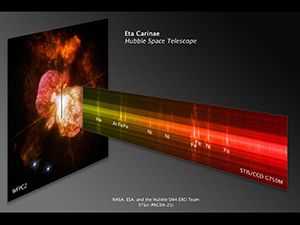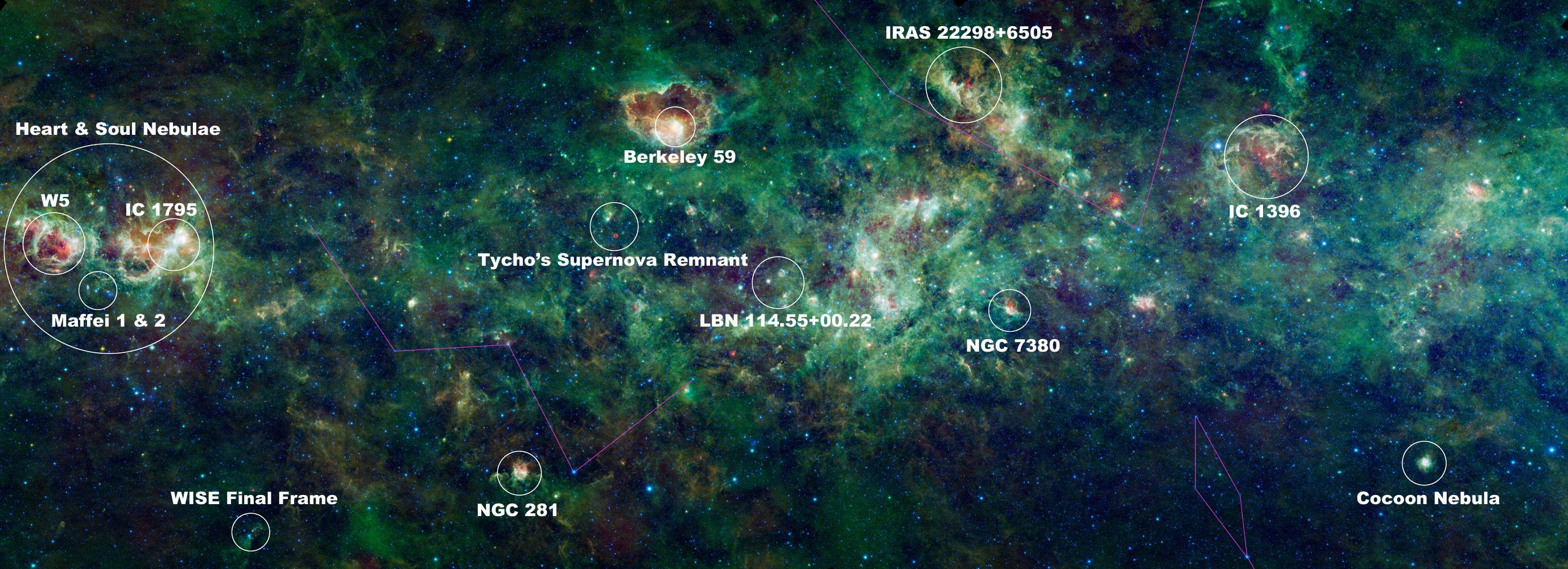Research Highlights
Research Highlights
Resolving and Characterizing the Massive Winds of Eta Carinae
For a decade in the 1840s, Eta Carinae brightened enough to rival Sirius, the brightest star in the night sky. It then gradually faded, only to brighten again in the 1890s, after which it faded to below naked-eye visibility. Today, an expanding bipolar nebula surrounds Eta Carinae, which now is slowly brightening again.
Astronomers eventually realized that Eta Carinae is a massive binary system still obscured by massive interacting winds. Its total radiation of 5 million solar luminosities suggests that the combined stellar mass must be at least 120 solar masses, divided between two components with an orbital period of 5.5 years. Both stars are sufficiently massive that eventually each will explode as supernovae. Studies of Eta Carinae in its current stage will lead to new insights on this near-supernovae class.
Ted Gull (NASA/GSFC) realized that the high resolution achieved by Hubble Space Telescope and the spectral dispersing properties of the Space Telescope Imaging Spectrograph could reveal the interacting winds of these massive stars.
During the final servicing mission to Hubble in May 2009, a failed computer board within the STIS was successfully replaced. The early release observation, designed to demonstrate that the HST/STIS was fully operational, was the first mapping of the winds of Eta Carinae. Ted Gull, Tom Madura, a NASA Graduate Student Research Fellow at University of Delaware, with Jose Groh (MPIR), and Mike Corcoran (USRA/GSFC) and colleagues, successfully proposed to continue these mappings in coordination with Chandra X-ray observations, sampling at specific times when the interacting wind structures were predicted to change. Contingent upon the HST/STIS being operational through early 2015, they will be testing and refining the interacting wind models by planned HST/STIS mappings.
Testing Models of Triggered Star Formation
The vast majority of stars are born in massive starforming regions. That makes these stellar factories extremely important to study, since the Sun itself was likely born in a large cluster of stars, perhaps in a long-since vanished massive star-forming region. But the details of how huge clusters of thousands of stars are born from giant molecular clouds and then disperse their birth environment remain unclear to scientists.
In particular, it has been thought for almost 60 years that the first stellar generation's most massive, hottest stars - O-type stars 20 to 100 times the Sun's mass - would promote further star formation in the cold molecular gas around them even as their radiation and winds disrupted and blew this gas away. Just how this triggered star formation happens, or if it happens at all, remains undetermined. Does gas gathered up by an ionization shock front then collapse into new stars, or does the hot ionized bubble of gas made by O stars radiation squeeze already overdense portions of the molecular gas into forming new stars
Xavier Koenig (ORAU/GSFC) and his colleagues have used data from the recently launched Wide-field Infrared Survey Explorer (WISE) telescope to study 11 such massive star-forming regions to answer these questions. They used photometry from 2MASS and WISE to find young stars in these regions by their excess of infrared emission between 1 and 22 microns and then look at their distributions across each region. The fact that 2MASS and WISE are both all-sky surveys now makes the task of mapping young stars across many square degrees of the sky quite straightforward.
The simplest picture is that the "collect and collapse" model of triggering would lead to a deficit of stars around the first generation, whereas the "squeeze" model would produce a continuous distribution of stars that would, on average, extend away from the center. Koenig and his co-workers found a smooth distribution of young stellar objects in these regions, thus supporting a "squeeze" origin in a radiatively driven implosion that triggered star formation in pre-existing dense structures.
Tidal Disruption of a Star by a Black Hole
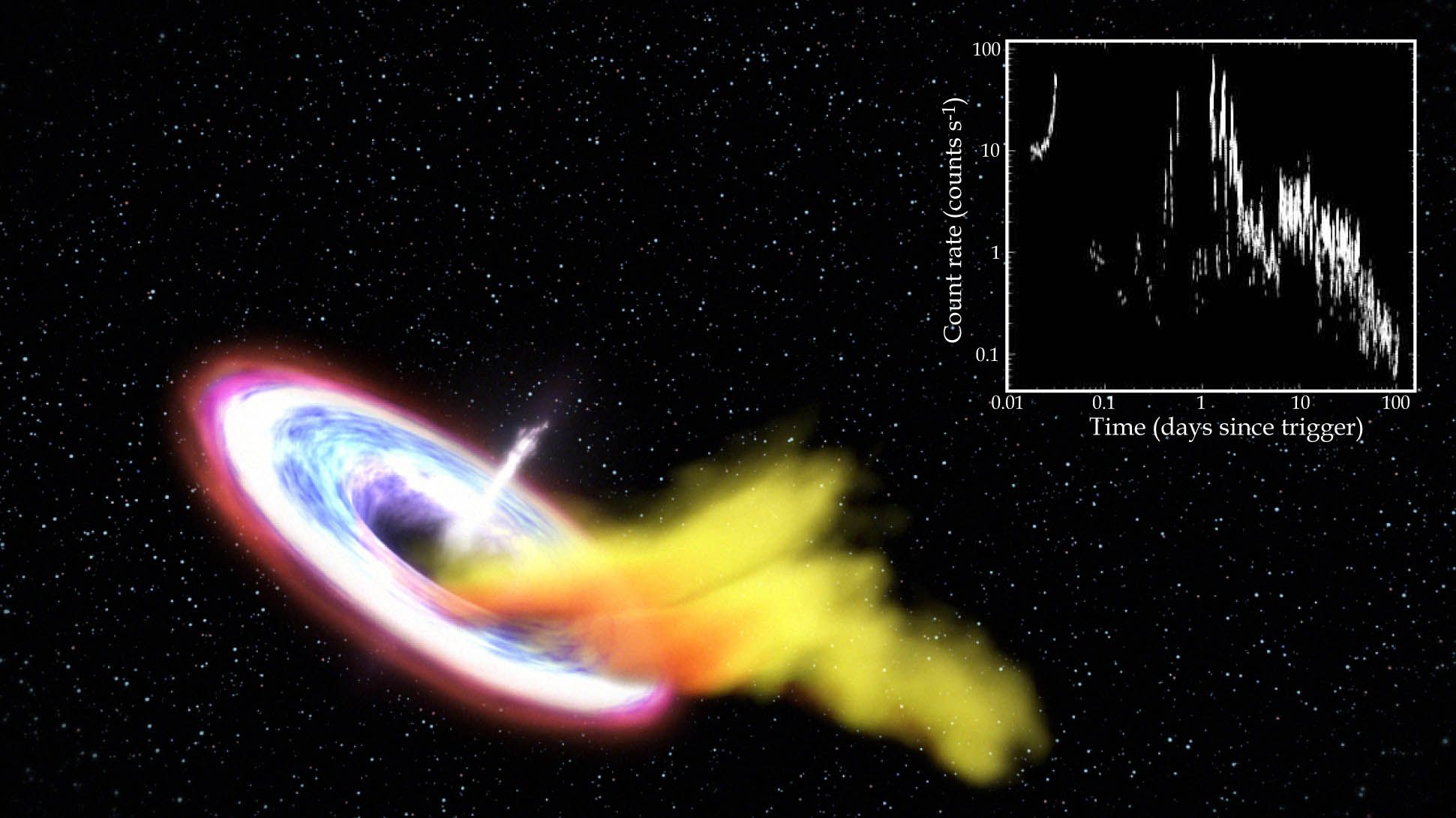
Given the massive black holes that are known to reside at the centers of most galaxies, an unavoidable consequence will be the occasional errant star wandering into the galactic center. If the stellar orbit lies within a certain range, the star can become disrupted and its shredded remains gobbled up by the central black hole. Furthermore, if our line-of-sight for such an event is roughly along the spin axis of the black hole, the jet produced by the sudden burst of accretion will boost the power output, making the event observable out to a large distance.
The BAT instrument on Swift discovered the first such jetted tidal disruption event (TDE) on 28 March 2011 coming from the center of a galaxy 1.4 gigaparsecs distant. Originally thought to be a gamma-ray burst and designated GRB 110328A, it is now known as Sw 1644+57. Evidence connecting the X-ray/gamma-ray source with a galactic mucleus was confirmed by precise HST, Chandra, and radio localizations. The strong circumstantial evidence associating the X-ray emission with the center of a dwarf galaxy strongly suggests a jetted tidal disruption event. There are several Swift team papers on the discovery and follow-up observations, including two in Science and one in Nature.
John Cannizzo (UMBC/GSFC) and Nora Troja (UMCP/GSFC), in collaboration with Giuseppe Lodato at the University of Milan, performed calculations to follow up on the idea of a tidal disruption event. Their work shows that, to explain the observations, the event needed to occur close to the event horizon of the black hole. This would result in a more violent stellar disruption than has been traditionally considered, hence they proposed the acronym TOE (tidal obliteration event) rather than TDE. An animation illustrating the event (http://www.youtube.com/watch?v=azLDH9ZPbVs) became the most watched video on Goddard's YouTube channel in just four days; in three weeks, it exceeded a million views. The X-ray light curve of Sw 1644+57's prompt phase is quite different from a gamma-ray burst's. It is surprising that such events have not been identified earlier, but now that we have some experience to guide us, a second such event has already been tentatively identified.
Probing the Intergalactic Magnetic Field with Fermi Measurements of the Extragalactic Gamma-ray Background
Cosmic magnetic fields are expected to play a fundamental role in the physics of a large variety of astrophysical systems. A definitive measurement of the intergalactic magnetic field (IGMF) could provide a fundamental step in resolving the questions of the origins of cosmic magnetic fields and their impact on the evolution of the systems in which they reside, but sufficiently constraining observations have thus far remained elusive. As such, for many areas of astrophysics, achieving a deeper understanding of the physics of the cosmos is hindered by our lack of understanding of the IGMF.
Ongoing theoretical investigations conducted by Tonia Venters (NASA/GSFC) and her colleague Vasiliki Pavlidou of the Max-Planck Institute for Radio Astronomy in Bonn, Germany and the University of Crete in Greece have examined whether the extragalactic gamma-ray background (EGB) as measured by Fermi's Large Area Telescope at GeV energies can shed light onto the nature of the IGMF. The EGB is a diffuse background of extragalactic gamma-ray radiation. While the exact amount of each of the postulated contributions to the EGB remains an open question, unresolved astrophysical sources of gamma rays such as active galactic nuclei and star-forming galaxies could comprise a large fraction. Additionally, there could be a contribution from truly diffuse radiation arising from the interactions of TeV gamma rays originating from some of these same sources: as TeV gamma rays traverse the cosmos, they interact with the photons of the cosmic microwave background (CMB) and the background of infrared, optical, and ultraviolet radiation from direct and dustreprocessed starlight. Pairs of electrons and positrons are created during these interactions, which will, in turn, Inverse Compton scatter CMB photons to high energies, thereby initiating an electromagnetic cascade.
A 5 µ Image of Beta Pictoris b at a Sub-Jupiter Projected Separation
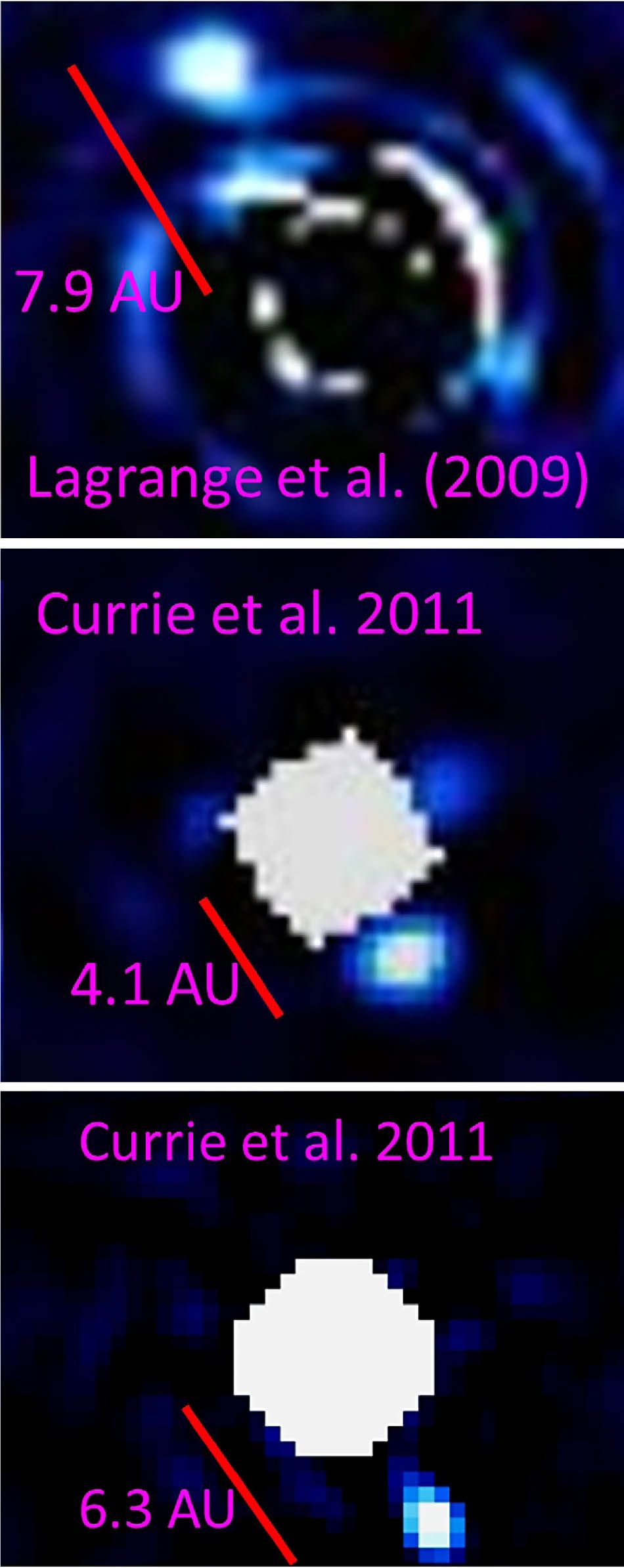
The nearby, 12-Myr-old A-type star Beta Pictoris was long suspected to harbor a young planetary system, and recently a ~9 Jupiter-mass planet (Beta Pictoris b) was discovered orbiting this star (Lagrange et al. 2009a, 2010). In these studies, the planet was detected at a projected separation of 8 AU (~0.4 arcsecond) from data taken in 2003 and at ~6-7 AU but on the other side of the star from 2009-2010 data, suggesting that the planet completed a substantial fraction of its orbit over the course of 7 years.
Thus, not only is Beta Pic b one of the few known directly imaged planets, but it also may provide a better comparison to the solar system's gas giants than other directly imaged planets (HR 8799bcde; Fomalhaut b), which orbit farther away from their host stars. Data taken between 2004 and 2008, when the planet was at a smaller projected separation, would better constrain its orbit. However, previous studies observing Beta Pic during this time only report nondetections (Lagrange et al. 2009b; Fitzgerald et al. 2009).
Thayne Currie (ORAU/GSFC) reexamined data from which previous studies reported non-detections of Beta Pic b, using a new state-of-the-art image-processing pipeline to beter extract faint planet signals from the glare of the host star. He detected Beta Pic b from archival M'band/5-micron VLT data taken in 2008, when the planet was at a projected separation of ~4 AU, and obtained a much sharper image of the planet from data where the planet was previously detected.
Combining these with other data where Beta Pic b was detected constrained the orbital properties and atmosphere of the planet. The planet likely has thicker clouds than do other substellar objects (e.g., brown dwarfs) of the same temperature, though the evidence for this is weaker than for planet around HR 8799. The planet's orbit is viewed almost perfectly edge on, and the planet has a Saturn-like semimajor axis of ~9.5 AU.
Intriguingly, Beta Pic b appears to have a longitude of ascending node of ~31°, which would put it in the plane of the main disk but misaligned with the warp/inclined disk at ~80 AU (offset by ~ 5°) that was discovered with Hubble Space Telescope observations. Previously, models for explaining the disk warp, and for estimating the planet's mass, assumed that the planet was misaligned with the main disk and aligned with the warp. These new results motivate new observations to better clarify exactly how Beta Pic b's orbital plane is related to the main and warped disk components, new dynamical modeling of the disk warp, and searches for other planets in the system that could induce dynamical structures in the disk.
Search for Dark Matter Using X-ray Observations of Dwarf Spheroidal Galaxies
The nature of dark matter is one of the outstanding unsolved problems in particle physics and astrophysics, and new physics will emerge with the identification of the dark matter particle. Searches for weakly interacting massive particle (WIMP) dark matter are, as yet, unsuccessful, and a number of observations of structure in the universe conflict with the Cold Dark Matter (CDM) paradigm. Therefore, consideration of alternative dark matter candidates is scientifically imperative.
The research program led by Michael Loewenstein (UMCP/GSFC) and Alexander Kusenko (University of California at Los Angeles, Institute for the Physics and Mathematics at the University of Tokyo) focuses on two particularly compelling keV dark matter candidates, although the results may be more generically applied. An ongoing study focuses on the keV-mass sterile neutrino. The existence of sterile neutrinos is predicted in most extensions of the Standard Model that explain the mass of the active neutrino. If their mass lies in the 1-30 keV range, they are a plausible (warm) dark matter candidate that may resolve some of the discrepancies in CDM models while explaining pulsar kicks and facilitating primordial star formation. Moduli dark matter, a novel and equally promising candidate, is the focus of their most recent effort. These fields are generically predicted in a large class of theories for physics beyond the Standard Model, and account for dark matter if the ratio of the scale of the new physics to the Planck scale falls in the range determined by anthropic selection.
The GISMO 2-millimeter Deep Field in GOODS-N
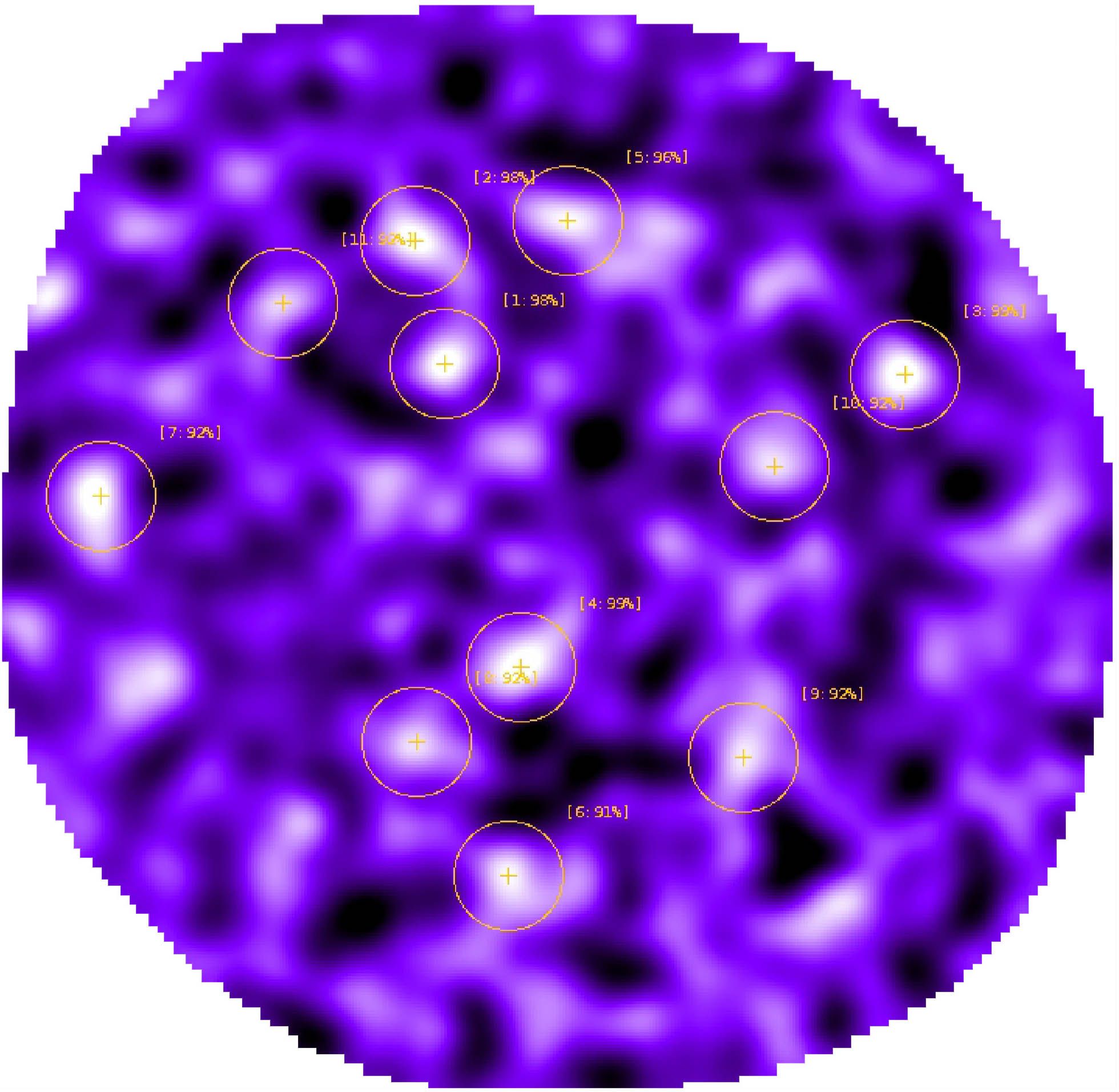
Extreme starburst galaxies are among the most luminous galaxies in the Universe, and the number density of these objects has gone through a significant evolution, peaking at redshifts z > 1. The most massive objects of this class are predicted to be at the center of galaxy clusters that reside in dark matter halos and therefore can be used to trace high-density regions in the early Universe. Rest-frame far-infrared continuum observations of luminous, dusty galaxies are well suited to determine the star-formation rate and the total energy output in these objects because virtually all of the stellar ultraviolet and optical radiation is being absorbed by interstellar dust and reradiated in the far-infrared. For large redshifts, the peak of the Spectral Energy Distribution (SED) of these galaxies is being shifted into the (sub-)millimeter regime. The first instrument that detected ultraluminous galaxies at high redshifts was SCUBA on the JCMT, which obtained the famous SCUBA-Deep Field in the HDF-N.
The 2-mm atmospheric window has not been astronomically explored from the ground to the same degree as shorter wavelengths (1.3 mm or less). The reason is predominantly of technical nature, namely the very demanding requirements on the noise performance of a background-limited camera, operating in this low opacity atmospherical window. For many years, ASD Observational Cosmology Lab members Harvey Moseley, Dominic Benford, Johannes Staguhn, and Elmer Sharp, in collaboration with Jhabvala, Miller, and Chervenak from Goddard's Detector System Branch, have been working on the development of low-noise superconducting Transition Edge Sensor (TES) bolometer technologies for the far-infrared (FIR). These efforts have yielded devices with sensitivities that exceed those required for the 2-mm ground-based observations. Consequently, Staguhn and other members of this group, plus Fixsen from the Observational Cosmology Lab, have built a 2-mm wavelength bolometer camera, the Goddard-IRAM Superconducting 2 Millimeter Observer (GISMO), for astronomical observations at the IRAM 30m telescope on Pico Veleta, Spain. Observations and data interpretation were additionally supported by Eliahu Dwek, Richard Arendt, and Stephen Maher from the Observational Cosmology Lab.
Rest-Frame Ultraviolet Star-Forming Galaxies at Intermediate Redshift Epochs
In order to explore the processes of galaxy evolution over cosmic time, it is vital to study its primary physical drivers, including the formation of stars within galaxies. Numerous data of distant (z > 2) and local (z = 0) galaxies have been analyzed by astronomers in order to calculate the cosmic star-formation history of the Universe which reveals a sudden decline in star-formation rate (SFR) density at z~1. The main processes that caused the drop in the SFR density are still unclear, and this remains a key open question in observational cosmology. Paralleling the decline of star-formation in galaxies is the emergence of Hubbletype galaxy morphologies (i.e., elliptical, spiral, barred spiral, irregular) that dominate the local Universe. In the distant Universe, most galaxies do not have these standard morphologies; instead, they are very irregular and can be interacting, live in groups and clusters, and have tidal tails and extended halos. Some of the defining questions of modern astronomy: When did galaxies obtain their Hubble morphologies? What physical mechanisms evolved galaxies into these well-defined morphologies?
Motivated by these broad questions, former NASA Goddard GSRP fellow Elysse Voyer, Observational Cosmology Lab scientists Drs. Duilia de Mello (NASA/GSFC) and Jonathan Gardner (NASA/GSFC), and their collaborators at NASA/ IPAC and UC Riverside have been conducting several studies on distant rest-frame ultraviolet star-forming galaxies that populated the universe ~4.5-9 billion years after the Big Bang, during the universal decline of the SFR density.
The Destruction of Interstellar Dust by Supernova Blast Waves
The presence of dust in the interstellar medium manifests itself by the extinction, reddening and polarization of starlight, its infrared emission, and by depleting the gas of important refractory elements such as carbon, magnesium, silicon, iron, titanium, and calcium. In spite of abundant observations, the cycle of dust is still poorly understood.
The supernova remnant (SNR) Puppis A offers a great opportunity to study the destruction of dust by a supernova blast wave. In a paper published in The Astrophysical Journal, Richard Arendt, Eliahu Dwek, and coworkers analyzed the dust properties, abundances, composition, and size distribution before and after the encounter with the SNR blast wave.
The X-ray models of the interaction region suggest that the shock velocity is about 5,000 km/s. By comparing these results to model simulations, scientists can calculate the total mass of dust destroyed by a single supernova remnant during its lifetime. To account for the total mass of dust seen in the interstellar medium, this mass must be balanced by dust formation in the different stellar sources. The multiwavelength analysis of the interaction of dust grains with supernova shock waves has put scientists one step closer to understanding the origin and evolution of dust in the interstellar medium.

Searching for Electromagnetic Counterparts to Gravitational-Wave Events
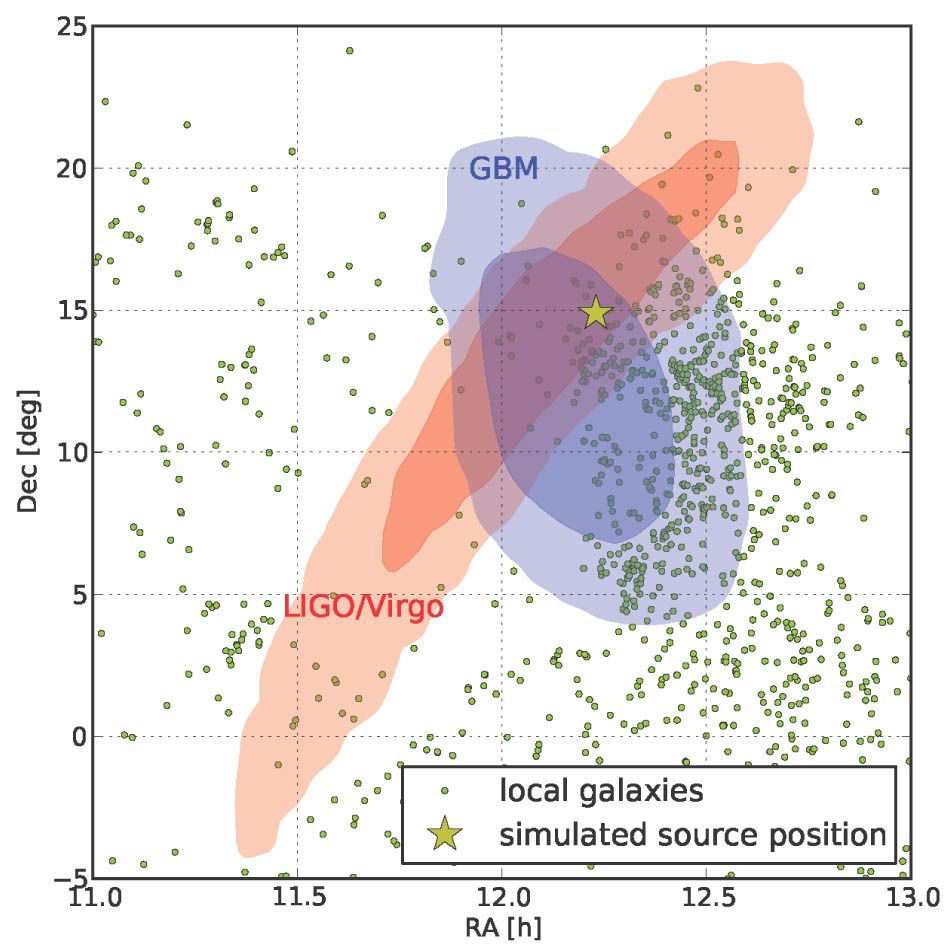
The next decade should mark the opening of the gravitational-wave sky as the Advanced LIGO gravitational-wave detectors come online with sufficient sensitivity to see tens of binary neutron-star (NS) coalescence events per year. As the principle progenitor model for short gamma-ray bursts (sGRBs), these are of particular interest to multi-messenger astronomy. Dr. Jordan Camp (NASA/GSFC) and NPP postdoc Dr. Lindy Blackburn (ORAU/GSFC) are helping to prepare for this era by designing coordinated searches between existing ground-based gravitational-wave detectors and NASA high-energy photon instruments.
The current search in development uses available science data from the first generation Initial LIGO and Virgo detectors collected during 2005-2010. The instruments operated near or in some cases beyond their design sensitivity (depending on frequency), and were able to detect an optimally oriented NS/NS coalescence out to ~30 Mpc. Existing searches have so far not seen any events loud enough to claim detection from gravitational-wave data alone. However, by requiring time and sky location consistency with an electromagnetic counterpart, the background of these searches can be dramatically reduced, which will allow a weaker event to stand out above transient noise sources.
The two instruments chosen for this coincidence study include the soft X-ray All-Sky Monitor (ASM) on RXTE and the Gamma-ray Burst Monitor (GBM) aboard Fermi. Both are particularly well suited for following up on gravitational-wave events because of their large, regular coverage of the entire sky and because the relative closeness of detectable gravitationalwave sources means the EM counterparts should be fairly bright.
BESS-Polar Long-Duration Flights

Among the most compelling questions in cosmology and astrophysics are the nature of the ubiquitous dark matter and the apparent dominance of matter over antimatter. The BESS-Polar (Balloon-borne Experiment with a Superconducting Spectrometer - Polar) instrument was developed by a collaboration co-led by GSFC (Dr. John W. Mitchell) and KEK (High Energy Accelerator Research Organization - Dr. Akira Yamamoto) for sensitive investigations of these questions in long-duration balloon flights over Antarctica. Mitchell, Makoto Sasaki (UMCP/GSFC), and Thomas Hams (UMBC/GSFC) are longterm members of the BESS-Polar team at GSFC and Kenichi Sakai (UMBC/GSFC) has recently joined after completing his Ph.D. using BESS-Polar II data. BESS-Polar succeeds the exceptionally productive BESS instrument that, in several progressively improved versions, made nine conventional one-day northern-latitude balloon flights between 1993 and 2002.

